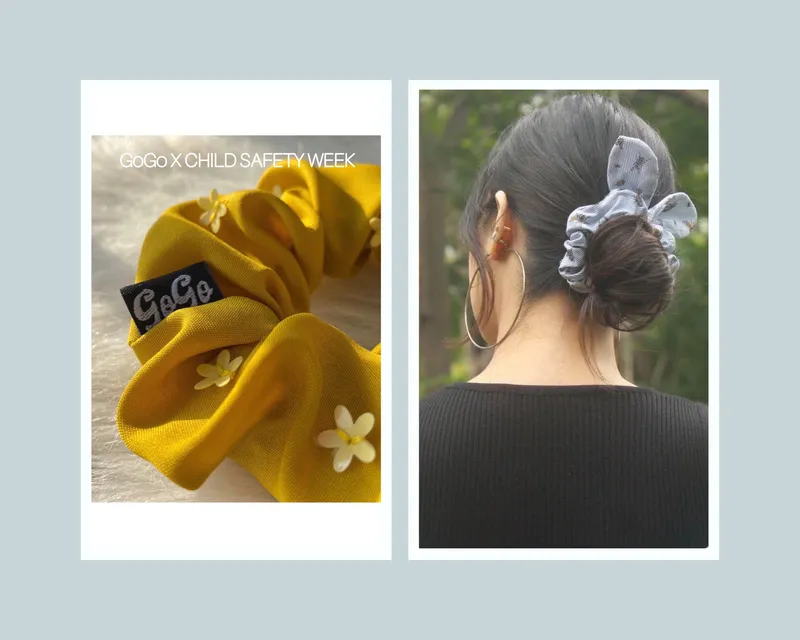How this NIFT graduate built a lockdown label, one scrunchie at a time
What started as a hobby soon became a small business that helped people manage their hair during the lockdown. Now, Sarthika Singha, who owns GoGo On The Go, is looking beyond scrunchies and wants to build an affordable lingerie brand.
When COVID-19 and the ensuing lockdown confined people to their homes, several hashtags began trending online—#socialdistancing, #flattenthecurve #quarantineandchill, #stayhomestaysafe—to name a few. One such hashtag that spoke volumes about the need for scrunchies, to manage long hair, was #lockdownlonghair.
And, 25-year-old Sarthika Singha, a NIFT-Chennai graduate and a fashion designer, was quick to take note of this.
Sarthika had moved to Nashik, to her parents’ place, from Mumbai (where she was working as a fashion designer and stylist) as she had fallen sick. But soon after, the coronavirus pandemic began, and she had to stay put in Nashik. With nothing much to do with her time, Sarthika—who loved to dabble in all things creative—decided to make scrunchies with the fabrics found in her house.
“In the middle of the pandemic, I was really frustrated because I didn’t have a job, and I was stuck at home in Nashik. I realised I had to do something within my own means instead of feeling frustrated, and I randomly picked up some fabric and decided to turn it into a scrunchie,” Sarthika tells HerStory.
When she posted a picture of one of her handmade creations on her Instagram page, her friends reached out to her, asking for more. As demand picked up, Sarthika found herself making more and more scrunchies.

Scrunchie, a wfh companion
The pandemic changed fashion trends in a big way, with people preferring casual and comfortable styling. Thus, loungewear, kaftans, flip-flops, headbands, hair ties, and scrunchies came to the fore.
With people working from home during the pandemic, scrunchies became a sort of work-from-home essential, according to Sarthika.
Scrunchies, which are primarily made from silk or velvet, are known to be less damaging on the hair and suitable for fuss-free ponytails and messy buns.
“They are gentle on the hair, and since they look cool too, there was a lot of demand for it from friends and family,” explains Sarthika.
One thing led to another and soon Sarthika created her own scrunchie brand called ‘’ (‘gogo’ is another name for ‘hair-tie’). In May 2020, she set up her brand on Instagram.
Her scrunchies are hand-sewn using upcycled fabric that is easily available at home, keeping in mind the idea of zero waste.
Sarthika has sold nearly 10,000 scrunchies (priced at Rs 100 per piece), in the last two years, purely through word-of-mouth and Instagram marketing.
“I’m proud of what I started during the pandemic. People don’t know me by name now, they call me GoGo. I feel good that I was able to create a small label,” says the young entrepreneur, who has now moved to Bengaluru.
Social impact
During the pandemic, Sarthika wanted to create an impact on society in some way. So, during the pandemic, she partnered with Chennai-based organisation Feed of Love to give away 50% of her earnings from GoGo On The Go to the NGO, which feeds homeless people. The association with the NGO still continues.
The entrepreneur is also training a couple of underprivileged women at a sewing centre in Bengaluru so that they can learn a skill and obtain a form of livelihood.
Beyond scrunchies
With the pandemic behind us, the demand for scrunchies has slowed down, admits Sarthika
“People shopped more when they were cooped up at home, but now that normal life has resumed, sales have slowed down.”
But this gives her an opportunity to explore other ways to tap into her creativity, she says. Sarthika is working on a Christmas collection of hoodies and socks.
So far, she’s been a one-woman army. But she believes it is now time to outsource the manufacturing to textile factories so that she can focus on the design and aesthetic aspects. She has already zeroed in on a factory for this.
During her time at NIFT, Sarthika specialised in knitwear and lingerie. So, she has her heart set on building her own brand of lingerie.
“I want to do sustainable, affordable lingerie because I struggle to find a good lingerie brand that is also affordable,” she says.
Edited by Swetha Kannan







